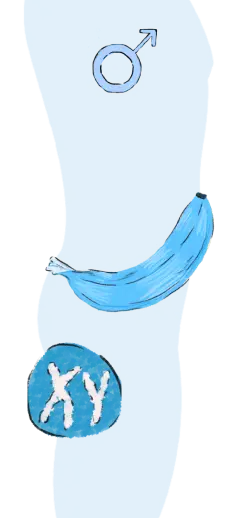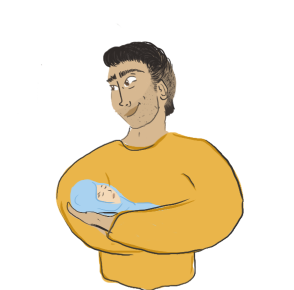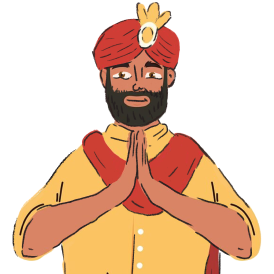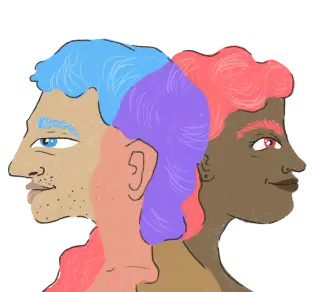

Empower Inclusivity
Empower Inclusivity
An essential step to better understanding ourselves is to start with the basics. To spot our similarities and differences and to recognise what makes us so diverse and interesting. You can start here!
While some terms and concepts may be new, confusing, or overwhelming, what’s important is that you find answers to at least some questions.
Remember, we may not capture everything perfectly, but we are keen to keep learning and improving as we go!

What is the difference between sex and gender?




‘Sex’ refers to the biological sex characteristics that we are born with and develop.
At birth, the most visible indication of our sex is our genitals. Accordingly, for medical purposes we are classified as male, female or intersex*.

However, sex is also connected to body shape, voice, body hair, hormones, chromosomes, etc.
Intersex* is when someone has mixed sex characteristics, biologically and physiologically.

Did you know
1.7% of people around the world are born intersex?

How is gender different to sex?
‘Gender’ is how we think a particular sex should look and behave. It is about perception.
These are unwritten rules on dress code, behaviour, interests and other characteristics.

Example:
A male (a person born with a penis) is physically and emotionally strong. He looks masculine and acts powerful. He is the breadwinner and protector of the family.


A female (a person born with a vagina) is physically and emotionally fragile. She looks feminine and acts timid. She is soft, nurturing and needs protection.

This is a very binary perception of gender roles!
Many such stereotypes we’ve created are being questioned and gender roles have changed over time.
Example:

Example:
A woman who is financially independent and chooses to not have children is perfectly acceptable in some societies and is still very unusual to others.



A man who is a professional dancer or a stay-at-home dad is common in some societies and very unusual to others.


This shows how we judge and perceive gender based on what is acceptable to us and our culture at a given time. Understanding that two cultures may have vastly different gender norms could be helpful, where one seems completely unacceptable to the other.






That is why gender is not fixed. It is all about how we feel people of a particular sex should look and behave.
Our right to live the way we want, should not be determined by gender stereotypes.


Where does identity come in?
While cultures and communities have created ‘norms’, each individual too, has their own understanding of their gender.

Gender identity refers to how we personally align ourselves with any gender or gender characteristics.
Think about the specific gender norms that make you comfortable or uncomfortable. What makes you feel empowered, and what makes you feel alienated?
Example:

Example:
Do you identify as a tough, strong man? Or are you calm and comfortable with expressing emotions? Do you relate to both?

Do you identify as a gentle woman? Or a powerful one? Could you be feminine and also very confident?

Were some characteristics you felt and emulated when you were younger, different to how you act and feel now?
The truth is there is no wrong answer. There is no one way we should feel.
Our association with gender is unique to us and these feelings may change over time.

Sometimes the behaviour others expect of us may not feel natural! Or we may be more comfortable being something in-between what people consider a real “man” or “woman”.
Our identity could fall somewhere along the spectrum of genders that exist out there. And of course, we may not know them all. That’s okay. As long as we don’t demean anyone simply because they are different to us.
Understanding the terms

Cisgender
When our feelings align with our biological make up.

Non-binary
A broad term for those who do not fit into the "male-female" or "man-woman" binary.

Transgender
A person whose gender identity is different to the gender assigned to them at birth.

Bigender
Fluctuates between the traditional "male-female" genders, displaying culturally "masculine" and "feminine" traits.

gender queer
Some whose gender identity or expression is not the same as society's expectation. This is an umbrella term for many non-binary identities.

Agender
Does not identify with any particular gender. Also described as being gender neutral/ gender-less.

genderfluid
A gender identity and presentation that shifts between genders or changes over time.
*The symbols used above are based on independent research and are not a formal representation of these categories.
DOES EXPRESSION MATTER?

We present ourselves to the world through our unique styles (makeup, accessories, clothing etc.,). Our ‘look' can hint at our identity.


Gender expression helps us to present and embrace our gender.
This especially matters of our identity doesn’t align with the ‘expected’ gender norms associated with our physical body.

Interestingly, gender expression that is culturally and socially accepted is changing all the time.
Example:


Example:
The formal attire worn by a Scottish bagpiper is tied to national identity and is a symbol of national pride. The traditional sarong/ lungi is commonly worn by men in South-East Asia. Yet a man wearing a skirt in a different context may be ridiculed or mocked.
There is no ‘right’ and ‘wrong’ when it comes to gender expression.
transitioning
This is when someone chooses to make changes to their physical body to match their gender identity. Just like we might cut our hair, pierce our body, and tattoo our skin, these changes help people embrace themselves and their identity.
Transitioning can happen in many stages

Telling others which pronoun you use is a part of social transitioning.

Changing your name is a part of legal transitioning.

Hormone therapy or surgery is a part of medical transitioning.
People choose to make some or all these changes depending on what makes them feel comfortable and empowered. Transitioning is a complex process that can take place over many years and some people do not make these changes at all due to lack of proper healthcare or a supportive environment.

Pronouns
It makes sense now why we can’t assume someone’s gender by simply looking at them. So, automatically referring to them as male/ female/ he/ she can be a misplaced assumption.
Given how expensive and complex the transitioning process is (and how resistant or unaccepting people can be), the trans and nonbinary experience is often difficult and painful.
Pronouns and labels used to identify people vary and it is best to ask someone how they identify than make assumptions!
If you meet someone new and you have an indication that they may be non-binary, give them the opportunity to share their pronouns and make it a point to remember and use them correctly.
This is similar to:
The honorific Mr. is used for men in general. For women however, Miss. is used for a young, unmarried woman while Mrs. is used for a married woman. For women who prefer not to be identified by or disclose their marital status, Ms. serves as a respectful and commonly used honorific. Similar to pronouns, it’s always respectful to ask someone their preferred form of address when writing their name on an invitation, for example.
The list and use of pronouns is extensive and evolving. There are many resources which can help in understanding what those pronouns are and how to use them. Here’s one.

How much do we know about orientation?

Orientation is about who we are attracted to, and there are several types of attractions that we can feel!

Sexual Attraction
This is straightforward and is usually what comes to mind first when we think of orientation. Sexual attraction is who we want to be sexually intimate with. This can include who we find physically attractive or sexually appealing.

Romantic attraction
This is about who we are drawn to in a romantic sense, to share experiences or be in a relationship with. For example, we may want to have heartfelt conversations, go on dates, hold hands, write romantic poetry about someone and this may not include any sexual desires.
While romantic and sexual attraction may overlap – they can still be identified separately. It might help to think of the difference between lust and love.

EMotional or intellectual attraction
This is about our attraction to someone’s thoughts and ideas, and the desire to be close through deep connection. It is about being drawn to someone for their personality and having a strong emotional understanding of one another.
To understand this better, think of someone you connect so well with that you can speak to them for hours, they just get you, your thoughts, feelings, ideas and ambitions. You might feel emotionally or intellectually stimulated after speaking with them. You might find this in friendship, or in a relationship.
It is often assumed that people are naturally only attracted to the opposite sex. But orientation isn't as straightforward, and people experience attraction in several ways.
Understanding the terms

Someone who is attracted to the opposite sex/gender is known as being “straight” or “heterosexual”.

Someone who is attracted to the same sex/gender is “homosexual”.

Someone attracted to more than one sex/gender is “bi-sexual”.

“Asexual” is when someone has little to no interest in sex at all ( feels no sexual attraction ) but may very well experience other types of attraction.
People living beyond the male-female binary have existed throughout history from ancient civilizations.
Amongst Native Americans, people were identified through the male/ female characteristics they embodied – their spirit, and not their orientation or genitalia. People known as ‘two-spirits’ embodied both male and female traits. They included androgynous people, feminine males or masculine females who often engaged in same-sex relationships. Not only was this seen as natural and accepted, but they were also seen as able to take on tasks of both sexes.
Similarly, indigenous Australians have sistergirls and brotherboys, terms used to describe trans and gender diverse people in Aboriginal or Torres Strait Islander communities. There are many such examples of Hijira in South Asia, Kathoey in Thailand, and many more across the world throughout history.
What we consider “unusual” may seem that way simply because it is uncommon, or we don’t have experience associating people who are different to us.
In any case, it isn’t right to demean or discriminate anyone, just as much as we wouldn’t want that for ourselves. Why not just... be nice!
Let’s embrace our differences and empower inclusivity.

